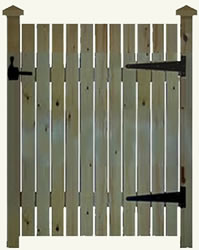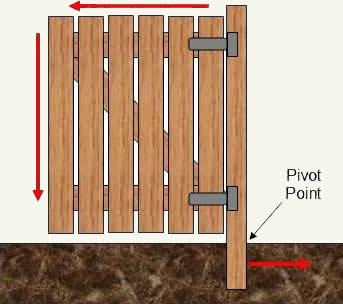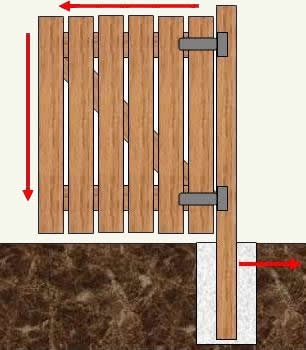A wood gate, as shown in Figure 1, can be an integral part of a fence or it can be a free standing structure. A wood gate can be functional; it can keep those you want, in, and those you don't want, out. Wood gates can also be placed in a landscape strictly for decorative purposes.

Figure 1 - Typical wood gate
Gate construction is not a complex project, but in order to have a gate withstand the normal day to day opening and closing and the weather, so that it does not jamb against its support posts or sag and scrape the ground, it is important to follow some basic gate construction tips and techniques.
Gate problems are caused by two situations:
- Incorrect support of the gate posts
- Incorrect construction of the gate.
Wood Gate Posts:
While gate posts are generally the same size on both sides of a gate, the important post is the one that has the hinges attached to it, as this is the post that receives all of the stresses and leverages that occur when the gate is opened and closed and even when in its stationary position.
Generally a gate post that is 4 × 4 is quite suitable to hold the weight of most residential wood gates. In fact it is not the size that is as important as how it is placed in the ground and if their are other structural members that will aid in keeping the post plumb, level and square.
Before you start constructing your gate post, it is important to understand the structural stresses that are inherent in wood gate construction.
The post, that has the hinges attached is being pulled in the direction of the gate, as shown in Figure 2, and because of the physical dimensions and weight distribution of the gate versus the post, the leverage is substantial. The wider the wood gate, the more stresses that are created on the gate post.
It should be remembered that the stresses on the post change direction when the gate is open.

Figure 2 - Wood gate stresses
Properly anchoring the post into the ground makes it more difficult for the hinge side gate post to pivot. The deeper the gate post is placed in the ground, the better its structural strength and adding concrete in the post hole is a tremendous aid to maintaining the gate posts structural integrity, as shown in Figure 3. At a minimum a gate post should be embedded in the ground 2 feet and 3 feet is much better.

